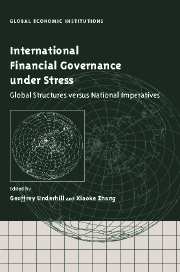Book contents
- Frontmatter
- Contents
- List of figures
- List of tables
- List of contributors
- Acknowledgements
- Introduction: global market integration, financial crises and policy imperatives
- I Financial globalisation and policy responses: concepts and arguments
- II Globalisation, financial crises and national experiences
- III Private interests, private–public interactions and financial policy
- IV Building the new financial architecture: norms, institutions and governance
- Conclusion: towards the good governance of the international financial system
- Index
Conclusion: towards the good governance of the international financial system
Published online by Cambridge University Press: 22 September 2009
- Frontmatter
- Contents
- List of figures
- List of tables
- List of contributors
- Acknowledgements
- Introduction: global market integration, financial crises and policy imperatives
- I Financial globalisation and policy responses: concepts and arguments
- II Globalisation, financial crises and national experiences
- III Private interests, private–public interactions and financial policy
- IV Building the new financial architecture: norms, institutions and governance
- Conclusion: towards the good governance of the international financial system
- Index
Summary
Reflecting on the causes of recent financial crises, former World Bank chief economist Joseph Stiglitz observed by analogy that when so many accidents occurred on the same road one needed to re-examine the design of the road. And indeed, the growing frequency and severity of financial crises have fostered a re-examination of the international financial architecture. The recent episodes of currency and financial crises in east Asia, Russia, Latin America and Turkey have provided the same watershed opportunity for rethinking the architecture of global finance as did the breakdown of the Bretton Woods order. In the wake of the Asian episode in particular, there has been a flurry of proposals on how the policies and institutions of the global financial regime should be reformed.
These reform proposals on the official ‘new financial architecture’ agenda, however, have remained limited in their intent and extent. While there has been progress in the development of international financial standards, efforts at exploring the optimal exchange rate regime, defining and encouraging private sector responsibility in crisis resolution and improving multilateral policy surveillance have been patchy and uneven. The modesty of proposed reforms to the global financial system have not been restricted to technical issues. The apolitical terms in which financial architecture debates have been couched serves to obfuscate the political dynamics that underlie and limit international efforts to restructure the global financial regime.
- Type
- Chapter
- Information
- International Financial Governance under StressGlobal Structures versus National Imperatives, pp. 360 - 383Publisher: Cambridge University PressPrint publication year: 2003
- 1
- Cited by



